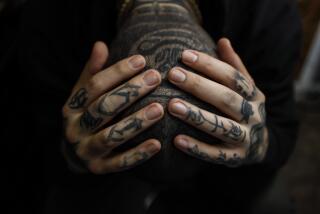Jeremy Lin puts the ball in Asian Americans’ court
The rise of New York Knicks basketball player Jeremy Lin has drawn fans as diverse as Harlem street ballers, late-night talk show hosts and Sarah Palin, but nowhere has his story been more deeply felt than within Asian Americans.
In the Asian American community even third and fourth generations must contend with being treated as perpetual foreigners. So it comes as no surprise that they have embraced the big pop culture bang that created “Linsanity” — a force that already has turned long-entrenched cultural stereotypes on their heads and made the Ivy League-educated point guard the most visible Asian American in the country, if not the world.
“[Lin is] definitely a departure from the invisibility or the erasing of Asian American-ness of Asian American players,” said Kathleen Yep, a Pitzer College professor of Asian American studies and author of “Outside the Paint: When Basketball Ruled at the Chinese Playground.” “There’s a fascinating thing of many people claiming Jeremy Lin ... as part of the American story.”
PHOTOS: Jeremy Lin: Absolute Lin-sanity
The overnight NBA sensation is also helping to change the conversation around Asian Americans and race, especially in the media, where the phenomenon has been fueled by social media chatter, 24-hour sports networks and a zero-to-hero storyline straight out of a movie script.
Last Friday, an ESPN mobile Web headline described the Knicks’ first loss with Lin with the racially tinged double-entendre “Chink in the Armor.” As social media protests erupted, ESPN not only issued an apology but also fired the headline writer and later suspended an on-air anchor who used the phrase in a separate story about Lin.
“I’ve never seen a media entity like ESPN act this fast to address a complaint,” said Los Angeles’ Phil Yu, who writes the popular Asian American news site Angry Asian Man and has covered similar media incidents. “That’s the Jeremy Lin Effect.”
PHOTOS: Jeremy Lin: Absolute Lin-sanity
Everyone seems to want a piece of Lin, be it conservative pundits who see affirmation in his devout Christianity and meritocratic rise or sports fans who love a good underdog, especially an undrafted benchwarmer now outplaying all-stars. But perhaps no one else but Asian Americans would claim Lin as “the new Obama” — as Dr. Ravi Chandra, a Psychology Today blogger, did recently, suggesting both men are “a representation of our best self on the world stage.”
If that comparison seems overblown, it’s partially because there are so few other precedents to invoke.
“The closest thing we’ve seen might well be Bruce Lee,” said Jeff Yang, who writes the “Tao Jones” column for the online Wall Street Journal. “But even Bruce Lee ... had to deal with perceptions that he was more import than domestic.”
In stark contrast, sportscasters and journalists have heavily emphasized Lin’s American-ness as a part of the story. Even film director and Knicks super-fan Spike Lee has taken to Twitter to correct people’s misconceptions: “Jeremy Lin Was Born Here In The US Which Makes Him An American. WAKE UP” read a Feb. 14 tweet.
For those still trying to get their bearings on Lin, the basic narrative is this: An unheralded Taiwanese American basketball player from Harvard, by way of Palo Alto, bounces around the NBA until the New York Knicks finally take him off the bench. He helped resurrect a moribund Knicks season, leading the team to eight wins in 10 games, including a nationally televised victory over the Lakers where Lin scored a career-high 38 points.
Some in the Asian American community are following “Linsanity” with caution, especially as commentators praise Lin for being “hard working,” “intelligent” and “humble,” words associated with long-standing stereotypes of Asian Americans. Chuck Leung, writing for Slate.com, expressed the fear that “beneath this Linsanity is an invitation for others to preserve these safe archetypes.”
Though Lin’s achievements may conform to the so-called “Model Minority Myth” of Asian American overachievement, his particular style of play works in a different direction, according to Jay Kang, senior editor for the L.A.-based ESPN spinoff site, Grantland. “I’m sure we’d all like to peg the humble Asian kid as unselfish,” wrote Kang. “But Lin can be a bit of a black hole [with the ball]. Some of his most exciting baskets have come on drives that start around half court.”
That was the case with one of Lin’s most signature moments thus far: a game-winning 3-point basket versus the Toronto Raptors where Lin deliberately counted down the game clock for 10 seconds until arching in his shot. Lin then turned and bounded toward his bench with a swagger reminiscent of former Lakers’ clutch shooter Robert Horry.
As Kang later shared, “the way that [Lin] celebrates even, it just seems like he’s ... a guy who grew up in American basketball culture and picked up its affectations, its pomp.”
In that sense, Lin is helping reshape the popular imagination around Asian Americans in sports, partially by normalizing their presence. Few NBA fans may realize that there’s a long history of Asian Americans in basketball, including a Chinese American team from San Francisco that barnstormed around the country with the Harlem Globetrotters during the Depression.
To many Asian Americans, Lin’s on-court heroics represent part of their own life stories. Yep, whose grandmother was a basketball player in the 1930s and has started watching Knicks games, played women’s basketball at Palo Alto High School, Lin’s alma mater.
“As someone who grew up playing basketball, who wanted to be the first Asian American NBA player,” she said, “it’s huge on a personal level just to know that we played in the same gym.”
Oliver Wang is a professor of sociology at Cal State Long Beach.
PHOTOS: Jeremy Lin: Absolute Lin-sanity
More to Read
Go beyond the scoreboard
Get the latest on L.A.'s teams in the daily Sports Report newsletter.
You may occasionally receive promotional content from the Los Angeles Times.










